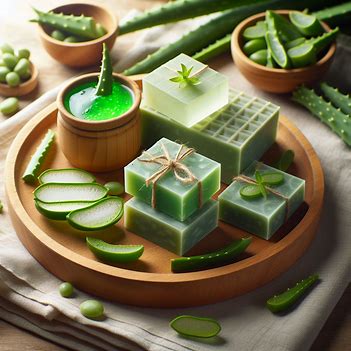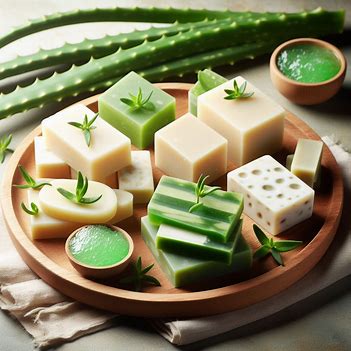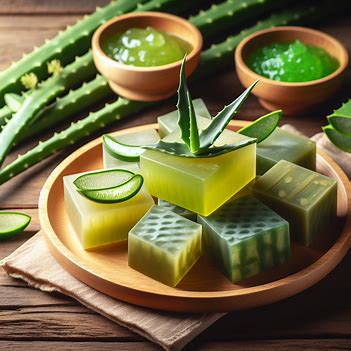In this article, we explore the amazing benefits of aloe vera for your skin. Learn how it can soothe irritation, fight acne, and even help you make your own nourishing soap at home.
Top Skin Benefits of Aloe Vera Soap
For centuries, people have turned to nature to find ways to look and feel better. One plant known for its amazing health and beauty benefits is aloe vera. In ancient Egypt, they called aloe the “plant of eternity” because of its incredible healing powers. Aloe vera is a succulent plant that originally came from the Arabian deserts.
Here are compelling reasons to make homemade aloe vera soap your new skincare staple:
Anti-Inflammatory Prowess
Aloe’s enzymes can soothe irritated, itchy skin and reduce inflammation.
Its ability to stimulate circulation creates a cooling effect, providing relief from swelling and rashes.
Related: Simple DIY Aloe Vera Skincare Recipes
Hydration
With its high water content, fatty acids, and amino acids, aloe soap moisturizes and locks hydration into your skin.
Yes, you can absolutely use aloe vera as a moisturizer!
Wound Healing
Salicylic acids in aloe gently exfoliate, sloughing off dead cells for a fresher complexion.
While some claim it can diminish stretch marks, the science isn’t conclusive yet.
Antioxidant Powerhouse
Vitamins A, C, and E – potent antioxidants found in aloe – neutralize free radicals that can cause premature skin aging.
Soap Secrets: Why Homemade Soaps Are Your Skin’s New Best Friend
Antibacterial Action
Saponins in aloe possess natural cleansing and antiseptic properties, making it excellent for combating acne-causing bacteria.
The Perfect Face Care Companion
Given its multitude of benefits, aloe vera is undoubtedly an ideal choice for facial skincare.
Those with oily complexions may find it a superior alternative to greasy moisturizers, as aloe gel leaves no heavy residue.
Keeps Skin Moisturized
Aloe vera soap is a natural moisturizer that hydrates the skin without leaving a greasy or oily residue.
The plant contains special polysaccharides that help lock moisture into the skin, preventing dryness.
This makes aloe vera soap an excellent choice for people with dry or sensitive skin types.
Soothes Sunburned Skin
Aloe vera is well-known for its ability to provide relief from sunburns.
The gel has a cooling effect and reduces inflammation, which helps minimize the redness and pain that come with sunburns.
Using aloe vera soap regularly can also help prevent sun damage to your skin over time.
Fights Acne Breakouts
If you struggle with acne, aloe vera soap can help. It contains salicylic acid, a natural exfoliant that unclogs pores and reduces inflammation.
Additionally, aloe vera has antibacterial properties that stop the growth of bacteria that causes acne breakouts.
Why Aloe Vera is The Soap Industry’s Game-Changer
With its anti-inflammatory, antioxidant, and moisturizing qualities, incorporating aloe into soap is a no-brainer.
Not only does it amplify the soap’s benefits, but it also provides unparalleled hydration.
Key Ingredients to Look For
While aloe soap is an excellent start for a creamy, moisturizing bar, seek out soaps that also contain ultra-nourishing ingredients like coconut milk, shea butter, and avocado oil.
This blend of gentle, natural ingredients hydrate dry, sensitive skin and create a protective moisture barrier.
Make your own homemade aloe vera soap
Seeking a homemade skincare solution that pampers your skin?
Look no further than aloe soap, a gentle and nourishing creation infused with the acclaimed aloe vera plant.
This step-by-step tutorial unveils the seamless process of handcrafting aloe soap.
Ingredients Needed
Aloe Vera Gel: The star component, either freshly extracted from an aloe plant or a store-bought variety.
Soap Base: A pre-made, mild, and transparent or white soap base, readily available at craft stores or online retailers.
Essential Oils (Optional): Fragrant additions like lavender, tea tree, or chamomile essential oils to amplify the sensory experience and potential skincare perks.
Soap Molds: Silicone molds, ideal for shaping your personalized soap bars.
Crafting Your Homemade Aloe Soap
Prepare Your Workspace: Establish a clean, organized area, ensuring all ingredients and tools are within easy reach.
Cut the Soap Base: Divide the soap base into smaller cubes for effortless melting. Adjust the amount based on your desired soap bar quantity and size.
Melt the Soap Base: In a microwave-safe container or double boiler, gently heat the soap cubes in short bursts until fully melted, stirring periodically for even consistency.
Incorporate Aloe Vera Gel: Once the soap base is melted, blend in the aloe vera gel. A general guideline is 1-2 tablespoons of gel per cup of melted soap base, but feel free to adjust to your preference.
Add Essential Oils (Optional): For a delightful aroma and potential additional skincare advantages, carefully introduce a few drops of your chosen essential oil. Exercise moderation, as a little goes a long way.
Pour into Molds: Carefully transfer the mixture into your soap molds, gently tapping them to eliminate any air pockets.
Allow to Set: Let the soap cool and solidify, a process that may take several hours or overnight, depending on the thickness and size of your bars.
Unmold and Store: Once hardened, delicately remove the soap from the molds. Store your handcrafted aloe soap in a cool, dry location or wrap it in wax paper to preserve its freshness.
While individual skin reactions may vary, performing a patch test before using any new skincare product is advisable. If irritation occurs, discontinue use immediately.
Aloe vera melt and pour soap recipes
What if you could create your own aloe vera soap bars at home, free from harmful chemicals? The soap-making process is not only enjoyable but also well worth your time and effort.
Step-by-Step Guide to aloe vera melt and pour soap recipe
Begin by cutting out the aloe vera soap base into small pieces and gathering them in a bowl.
The sulfate-free base is perfect for creating beauty bars without the need for specialized equipment.
Gently melt the soap base using a double boiler over medium heat or, for smaller batches, a microwave-safe jar in the microwave.
Stir the soap base until it achieves a liquid consistency, using a reusable soap stirrer.
Infuse the liquid base with your preferred fragrance
Enhance the aroma with fragrance oils
Carefully pour the liquid into silicone molds and allow it to set for several hours. (Unlike traditional soap, melt and pour soap bases do not require a 24-hour curing time before use.)
Once set, remove the soap bars from the molds and store them in an airtight container for daily use.
Tags:
facial soap bar recipe
pure aloe vera soap recipe
aloe vera soap

I’m a devoted organic skincare enthusiast, passionate about the natural, wholesome goodness that organic products bring to our skin.
Organic skincare isn’t just a hobby for me—it’s a lifestyle. Every product I use, recommend, and write about has been carefully chosen for its purity and effectiveness. Everything I write about is backed by scientific studies, dermatologists’ opinions, and user experiences.
I also excel at tackling skincare challenges with innovative, organic solutions.





